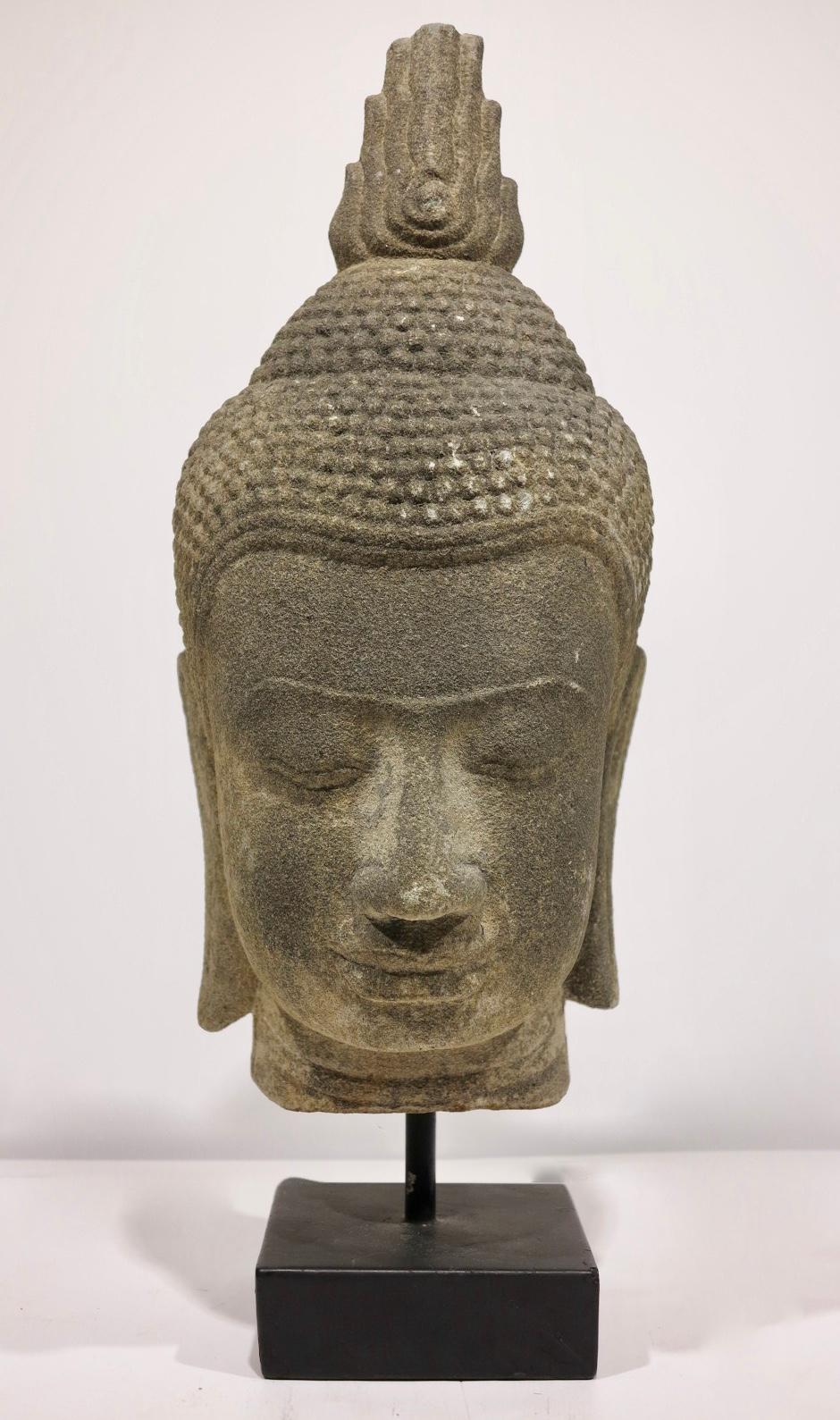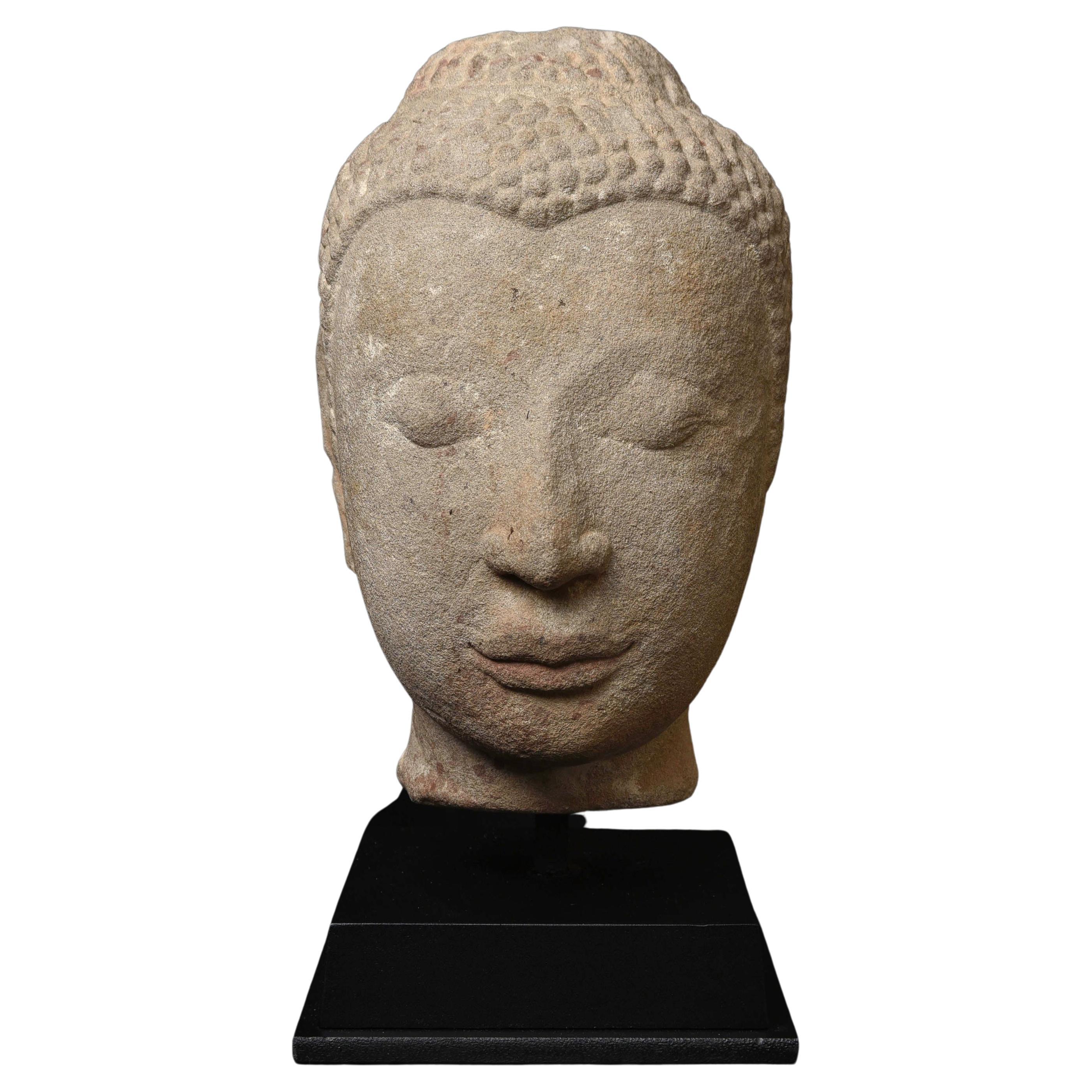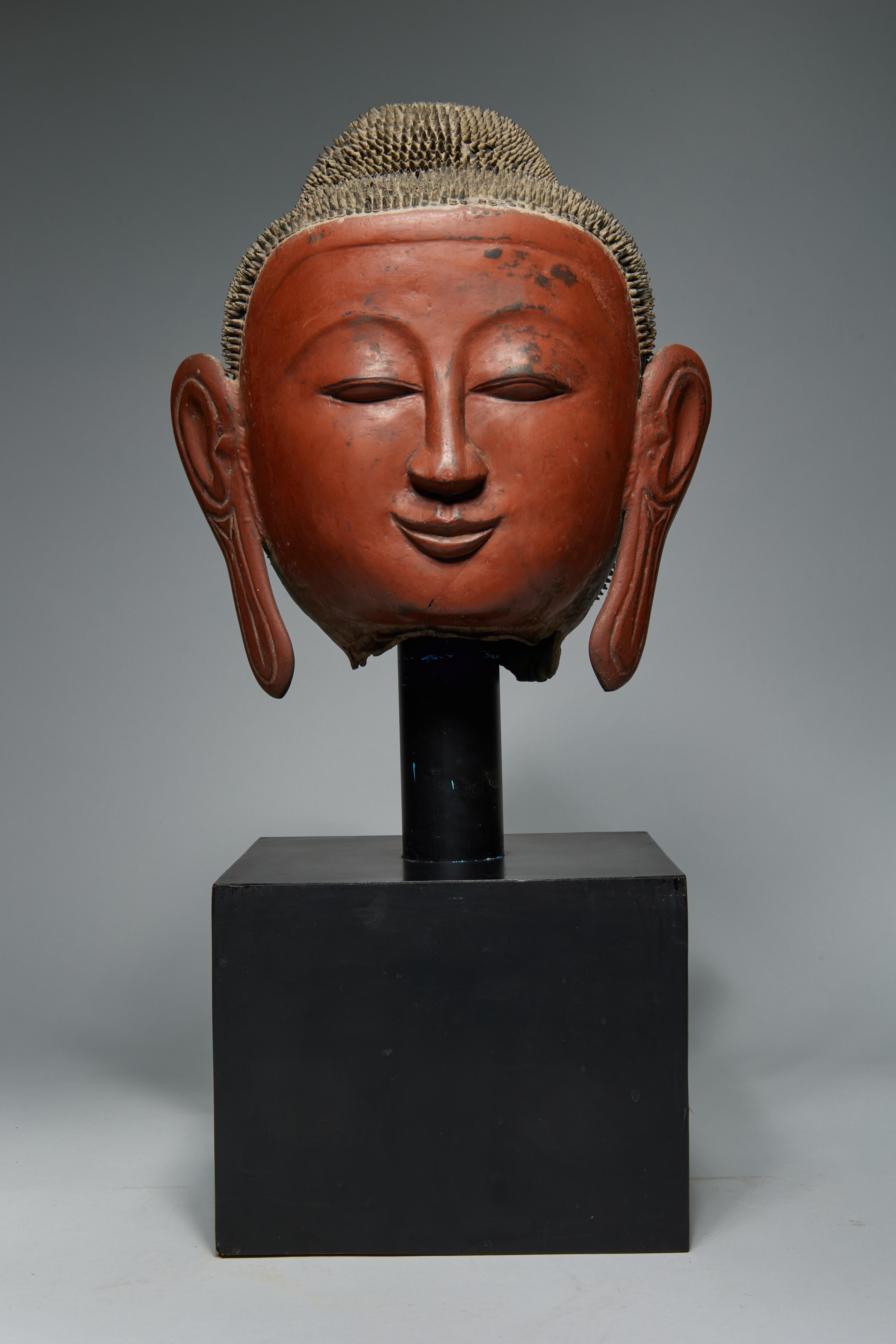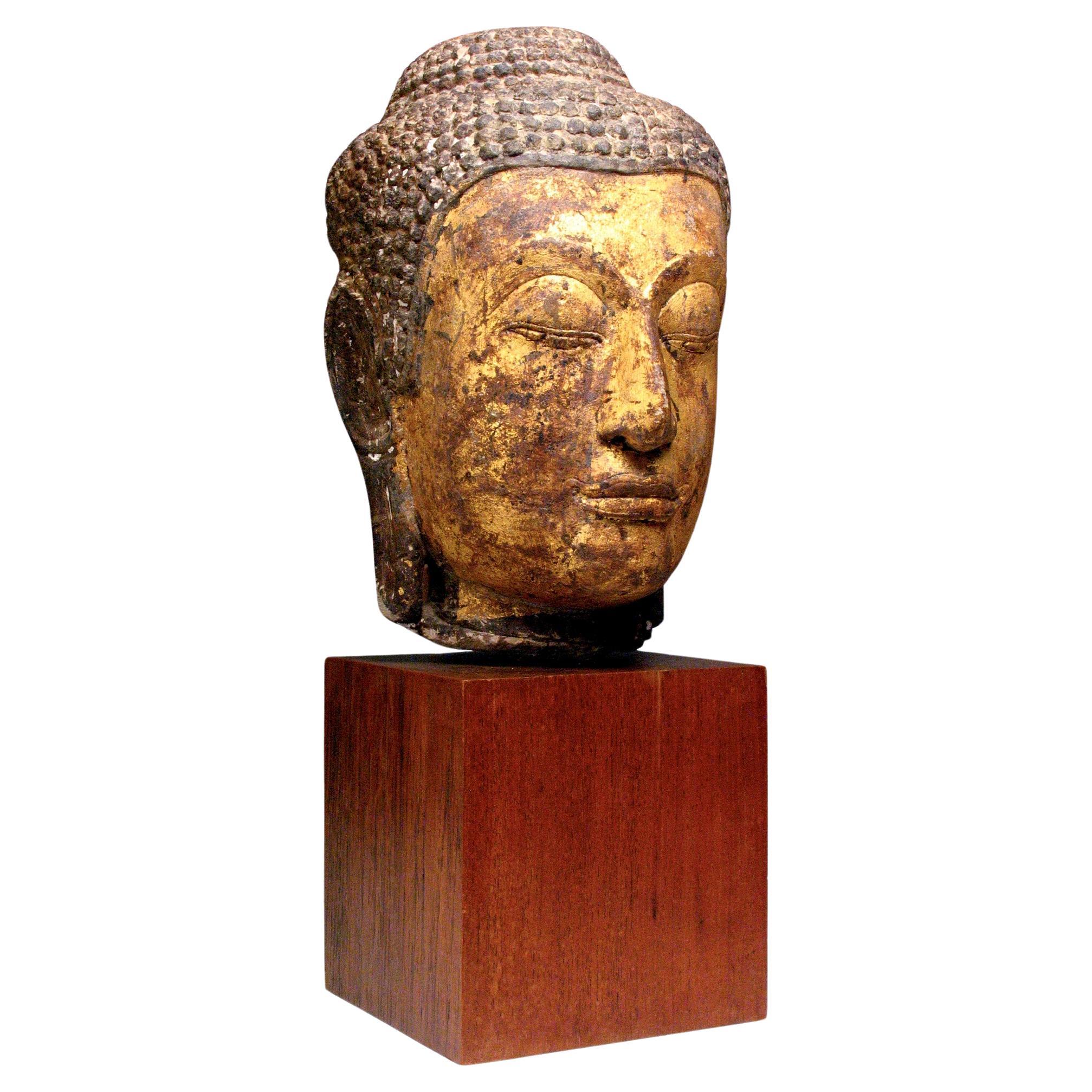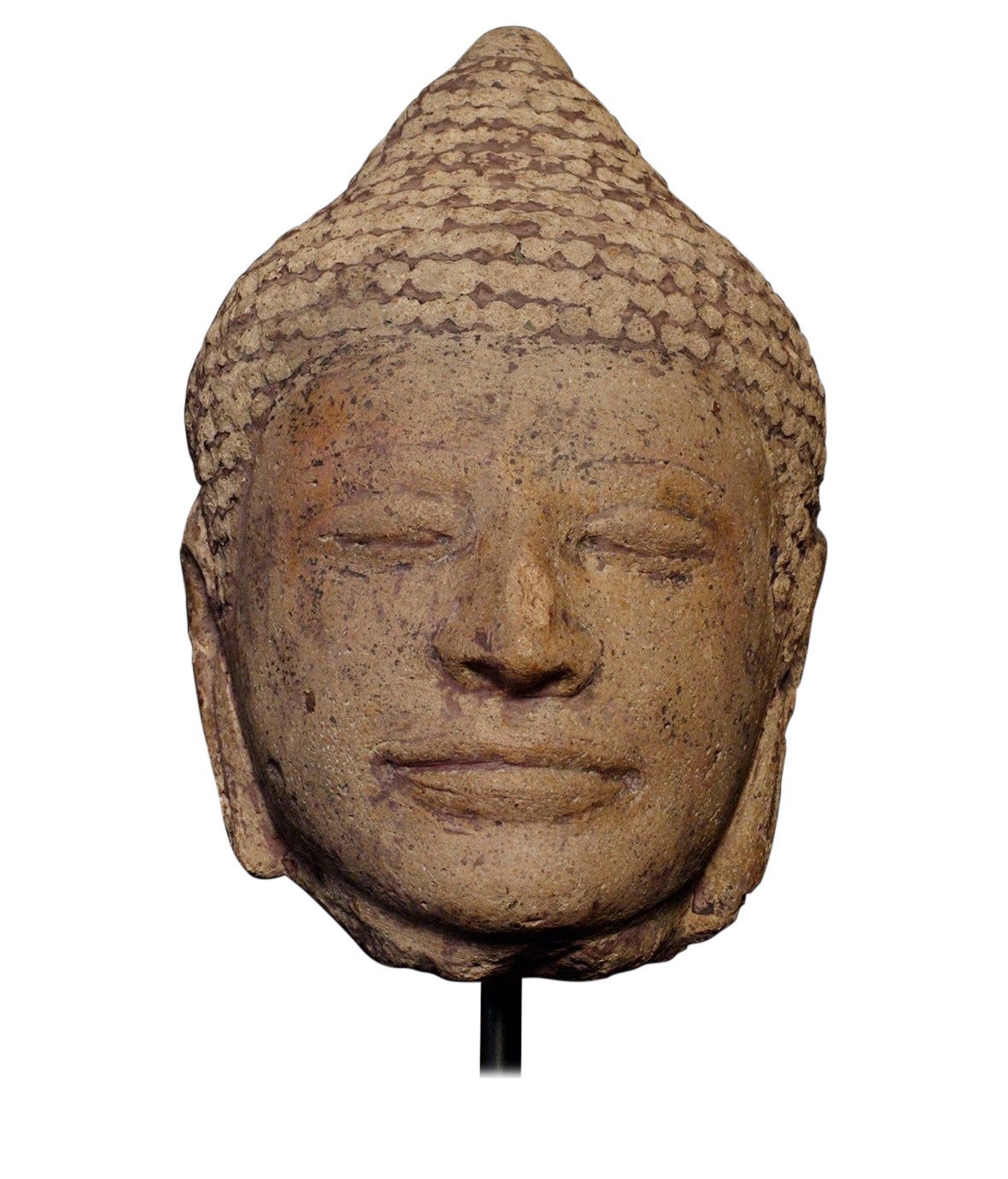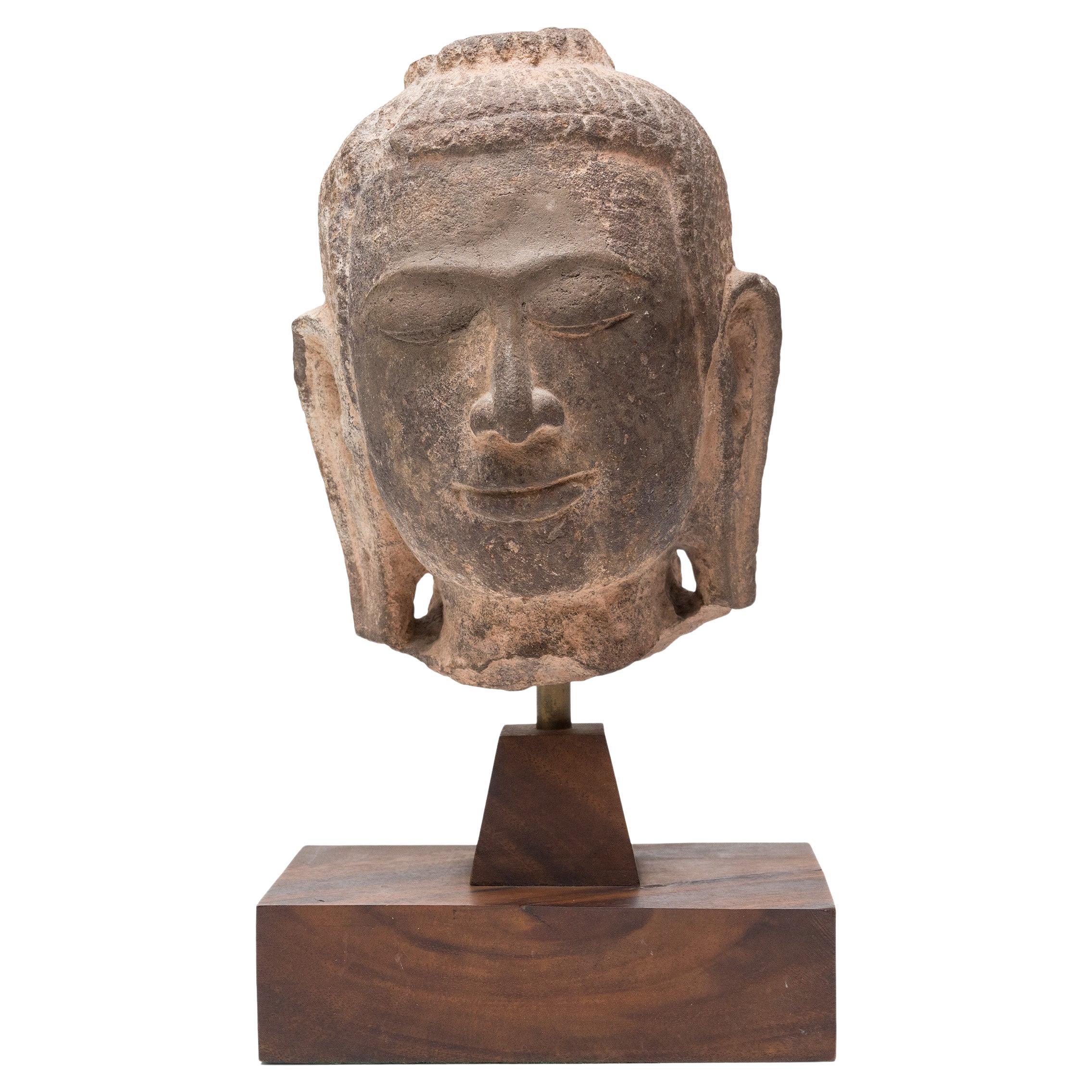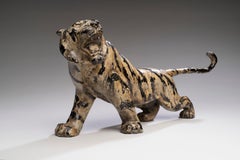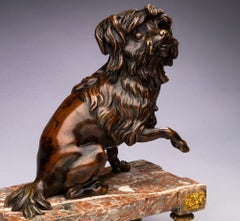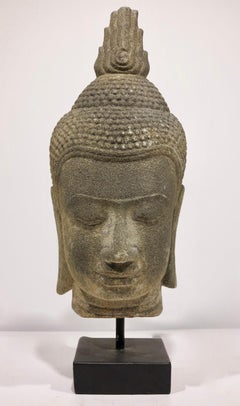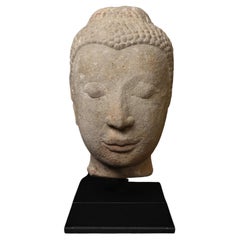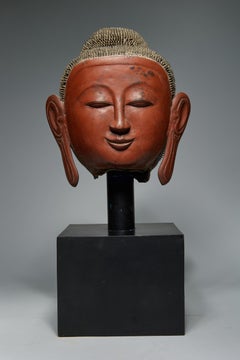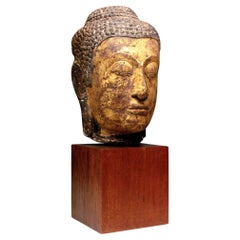Items Similar to Large 17th century, Sandstone Buddha Head from Thailand, Ayutthaya Kingdom
Want more images or videos?
Request additional images or videos from the seller
1 of 9
UnknownLarge 17th century, Sandstone Buddha Head from Thailand, Ayutthaya Kingdom17th century
17th century
$10,000
£7,642.98
€8,809.15
CA$14,321.92
A$15,696.39
CHF 8,196.95
MX$188,338.59
NOK 102,926.76
SEK 96,953.19
DKK 65,781.84
About the Item
Large Sandstone Head of Shakyamuni Buddha
Thailand (formerly Siam), Ayutthaya Kingdom
17th century
16 1/2 inches on stand, 11 1/3 without
Private collection, France.
The face is set in an oval and has large curvilinear brow arches with perfect curvature meeting at the base of an aquiline nose with dilated nostrils. The almond-shaped eyes with half-closed eyelids, the mouth with a wide smile and full lips have pronounced corners reminiscent of the art of Sukhothai. The hair, dotted with a multitude of small spikes, is delimited by a fine edging and forms a delicate V at the forehead. Surface is a lightish grey tone.
The Historic City of Ayutthaya, founded in 1350, was the second capital of the Siamese Kingdom after Sukhothai. It flourished from the 14th to the 18th centuries, during which time it grew to be one of the world's largest and most cosmopolitan urban areas and a center of global diplomacy and commerce. European travelers in the early 16th century called Ayutthaya one of the three great powers of Asia (alongside Vijayanagar, India and China). The Ayutthaya Kingdom is considered to be the precursor of modern Thailand, and its developments are an important part of the history of Thailand.
The kingdom extended from part of what is now eastern Myanmar (Burma) and western Laos, all the way south to what is now northern Malaysia. It was destroyed by the Burmese in the 18th century.
- Creation Year:17th century
- Dimensions:Height: 16.5 in (41.91 cm)Width: 8.66 in (22 cm)
- Medium:
- Period:
- Condition:Condition is very typical of pieces from this period & region. There are elements missing, scratches and some depressions; it is in overall good condition. Fragmentary nature & the passage of time have created a compelling patina. Repairs to nose.
- Gallery Location:SANTA FE, NM
- Reference Number:1stDibs: LU1408214491572
About the Seller
5.0
Platinum Seller
Premium sellers with a 4.7+ rating and 24-hour response times
Established in 1995
1stDibs seller since 2020
123 sales on 1stDibs
Typical response time: 1 hour
- ShippingRetrieving quote...Shipping from: Santa Fe, NM
- Return Policy
Authenticity Guarantee
In the unlikely event there’s an issue with an item’s authenticity, contact us within 1 year for a full refund. DetailsMoney-Back Guarantee
If your item is not as described, is damaged in transit, or does not arrive, contact us within 7 days for a full refund. Details24-Hour Cancellation
You have a 24-hour grace period in which to reconsider your purchase, with no questions asked.Vetted Professional Sellers
Our world-class sellers must adhere to strict standards for service and quality, maintaining the integrity of our listings.Price-Match Guarantee
If you find that a seller listed the same item for a lower price elsewhere, we’ll match it.Trusted Global Delivery
Our best-in-class carrier network provides specialized shipping options worldwide, including custom delivery.More From This Seller
View AllSeated Japanese Amida Nyorai Buddha ; Early 20th century.
Located in SANTA FE, NM
Seated Japanese Amida Nyorai Buddha
Polychrome porcelain
Japan, Meiji era, early 20th century
Satsuma Kilns
11 1/2 x 6 1/3 x 6 1/3 inches
...
Category
Early 20th Century Figurative Sculptures
Materials
Enamel
Painted Cast-Metal Tiger circa 1900
Located in SANTA FE, NM
Painted Cast-Metal Tiger
Continental School, circa 1900
8.75 x 19.5 inches
Ex. Collection Interior Designer Joseph Cicio
Born and raised in Brooklyn, New York, Joseph Cicio followe...
Category
Early 20th Century Academic Figurative Sculptures
Materials
Metal
Antique 19th century Bronze Dog Portrait of a Löwchen on a Marble Base
Located in SANTA FE, NM
Antique Bronze Dog Portrait of a Löwchen on a Marble Base
French 19th century
1/2 x 8 x 5 1/2 inches
The chiseled bronze has a nuanced, rich brown patina depicting a Löwchen in the round, seated on a quadrangular marble base decorated with very fine gilt bronze flowers and fluted feet. Napoleon III, Louis XVI style. Based on a model by Jacques Caffieri for the Prince de Condé in 1773.
(More images to be added.)F
Executed during the nineteenth century, this figure is fully in line with the eclectic taste of the reign of Napoleon III. Indeed, the Empress Eugenie brought the Louis XVI style up to date in her castle of Compiègne. Jacques Caffieri is one of the most famous bronze smiths of the eighteenth century. In 1715 he was admitted as a master caster and chiseler, and worked almost exclusively for the crown castles...
Category
19th Century Rococo Figurative Sculptures
Materials
Marble, Bronze
Pair of Italian "Alabaster Stone Lions" after Antonio Canova; Mid 19th Century
Located in SANTA FE, NM
"Pair Recumbent Stone Lions"
after Antonio Canova (1757-1822)
Italian (possibly Florence)
Mid 19th Century
Alabaster, marble
6 x 9 x 4 inches
This is an exquisite pair of Italian alabaster lions on marble bases based on the monumental lions carved by Antonio Canova (1757-1822), the greatest Italian neoclassical sculptor. Canova sculpted the marble lions for the monumental tomb of Pope Clement XIII in St. Peter’s, Rome in 1792
Canova Lions refers to the pair of copies of lion sculptures by Antonio Canova. When Canova created the sculptures in 1792, he installed them on the tomb of Pope Clement XIII. The marble sculptures are some of the most prominent features in St. Peter's Basilica in Rome. Given the intricacies of creating the original Canova lions, some artists created molds and replicated them. A good example is the pair of lion sculptures...
Category
1850s Italian School Figurative Sculptures
Materials
Marble, Alabaster
Set of Three 19th century Tibetan Tsakali with Depictions of Dancing Dakinis (B)
Located in SANTA FE, NM
Set of Three 19th century Tibetan Tsakali with Depictions of Dancing Dakinis
Mineral pigment on paper
Approximately 4 1/2 x 4 inches each (23 x 14 1/2 frame)
It's important to note this are very fine examples of Tibetan tsakali; more akin to fine art than the usual Tibetan artifacts...
Category
19th Century Figurative Paintings
Materials
Handmade Paper, Pigment
Antique 19th cent. Dog Portrait Jack Russell Terrier by Pierre-Albert Laplanche
Located in SANTA FE, NM
Antique Bronze Dog Portrait of a Terrier
Pierre-Albert Laplanche (French, 1826-1873)
Signed in script to base "Laplanche"
Stamped "E.V 3753"
8 x 2.75 x 8 1/4 inches
This is a super...
Category
Mid-19th Century Academic Figurative Sculptures
Materials
Bronze
You May Also Like
Sandstone head of Buddha, Khmer, Angkor period, post-Bayon
Located in Wilton Manors, FL
Beautiful Khmer head of Buddha. Angkor period, style of the post-Bayon. 14th century. Carved sandstone. Height 12 5/8 inches, width 5 5/8 inches, profile 5 ...
Category
15th Century and Earlier Figurative Sculptures
Materials
Sandstone
16th Century Thai Life Size Stone Buddha Head-Superb Ayuthaya Example
Located in Ukiah, CA
Life-size 16th century Thai stone head. The face is absolutely classic for this type--powerful, kind, and calm. The condition is very good, as can be seen in the photos. Large Buddhas...
Category
Antique 16th Century Thai Sculptures and Carvings
Materials
Stone
19th Century Burmese School Buddha Head of the Shan (Tai Yai) Style
Located in Beachwood, OH
Burmese School, 19th Century
Buddha Head of the Shan (Tai Yai) Style
Wood with red lacquered pigment
25 x 13 x 10 inches
dry lacquer form with finely sculpted features such as the e...
Category
19th Century Figurative Sculptures
Materials
Wood, Lacquer
Thai Sandstone Carving of the Head of A Buddha Image
Located in Point Richmond, CA
Thai Sandstone Carving of the Head of A Buddha Image, Ayutthaya, 15th Century. This sculpture has carved features with full lips outlined with an incised line known as a “trace”, the “U” of the chin broad, long aquiline nose , protruding large and arched eye lids with the eyes narrowly open revealing the pupils, over arching brow continuing the line of the nose, short forehead, a thin raised outline as the hairline surrounding the face, 6 rows of round boss hair curls to the domed usnisa covered in 5 rows of hair curls, large ears with attenuated earlobes reaching to the break at the neck, flat top to the usnisa and a flat area to the back of the head. The facial surface gessoed lacquered and gold leafed, the rest of the head with Varied surface mottling and lacquer remnants mostly revealing the sandstone texture of the material. Mounted with a post and drilled interior hole to a large solid teak block as a contemporary stand.
Condition: A sculpture fragment from a large Buddhist Image, The head has been removed at the neck and the flat area at the top of the head would indicate that another mortared segment would have originally been attached possibly an undulant unalom finial, otherwise remarkably fine.
Measuring: 23-1/8 inches high overall, the sculpture is 15 inches high x 10 inches wide x 10-1/4 inches deep. The wood base is 8-1/8 inches high x 7-7/8 inches wide x 7-5/8 inches deep.
Provenance:
with Kenneth Brown Jewelers...
Category
Antique 15th Century and Earlier Thai Other Sculptures and Carvings
Materials
Sandstone
13/14thC Thai or Khmer Solid Terracotta Buddha Head, 7278
Located in Ukiah, CA
13/14thC Thai or Khmer solid terracotta Buddha head. Very beautiful life-size face that beautifully shows the transition between Khmer and Thai ...
Category
Antique 15th Century and Earlier Thai Antiquities
Materials
Terracotta
$3,115 Sale Price
30% Off
Limestone Shakyamuni Buddha Head, c. 1800
Located in Chicago, IL
With closed eyes and a gentle expression, this southeast Asian stone bust depicts the historic Buddha Shakyamuni in calm meditation. Also known as Shaka, Gautama Buddha, or Prince Si...
Category
Antique Early 19th Century Southeast Asian Archaistic Sculptures and Car...
Materials
Limestone
More Ways To Browse
Antique Kingdom
Antique Buddha Sculpture
Antique Sandstone
Black Head Sculpture
Buddha Siam
Buddha Head
Black Buddha
Antique Malaysia
Large Buddha Sculpture
Antique Buddha Head
17th Century Buddha
Large Head Sculpture
Thailand Head
Black Buddha Sculpture
Thai Buddha Heads
Large Thai Sculpture
Buddha Sandstone
Sandstone Head Sculpture
